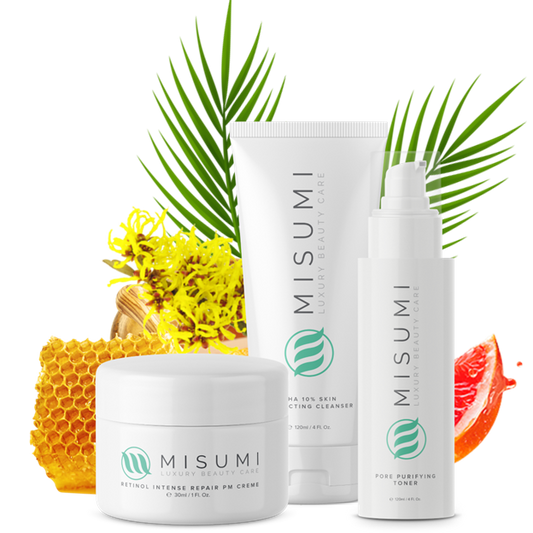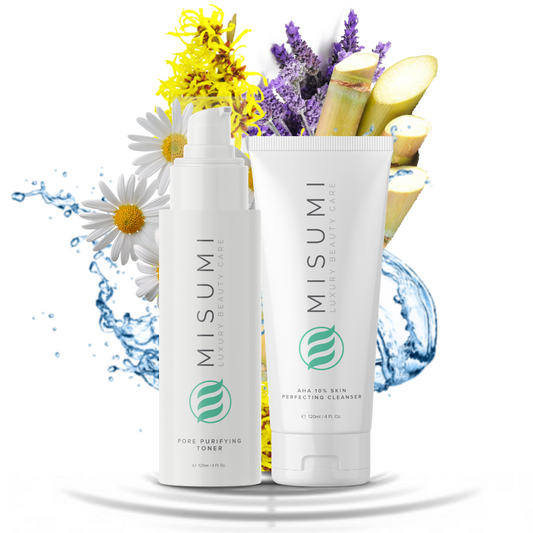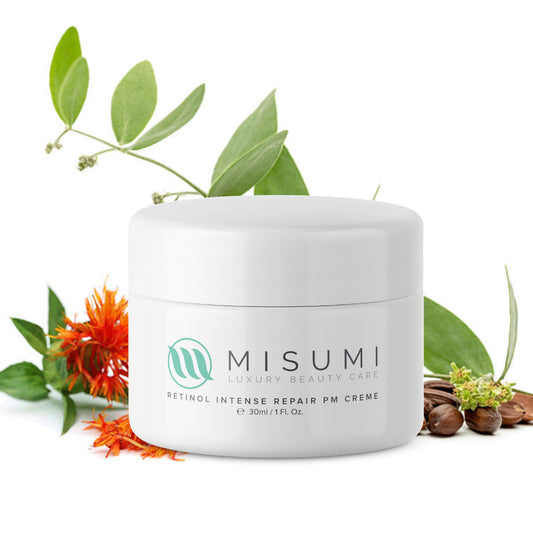Acne is an annoying long-term condition that affects the skin and mental health of many teenagers and adults worldwide. Everyone at some point has had to deal with an inflamed pimple, but unfortunately, many of us are dealing with a much more severe acne problem.
When medical and over-the-counter acne treatments fail and irritate the skin more than they help, you can't help but think: it shouldn't be this hard to get normal-looking, clear skin!

And, you're right! It shouldn't!
That's why we're here, looking into witch hazel for acne as an alternative approach that might help you get what you desire.
This amazing plant has been around since the beginning of our civilization, and since then, people have always used it for its healing powers. We'll examine its potential anti-inflammatory activity and all the other possible benefits.
But how does witch hazel work? How can you use witch hazel for acne? Let's find out.
What Exactly is Witch Hazel?

Witch hazel (Hamamelis) is a type of flowering plant that is native to North America, China, and Japan. But, the most common type is found in North America. It's also frequently called winterbloom.
Just to address the elephant in the room - no, the name is not in any way related to the meaning of the word "witch" in English (a practitioner of magic). Actually, the plant's name probably comes from the old English word wice which means "to bend." At that time, people generally attached the word "wice" to various trees with pliant branches.
Sorry to disappoint you - no interesting history there. But, the plant itself has something much more interesting to offer.

Since the beginning, Native Americans used witch hazel extract exclusively for medical purposes. They would boil the shrub's stems to treat swellings, inflammations, and even tumors. Later, the plant became so famous that it grabbed the attention of chemists, who then studied it and discovered that its twigs are even more effective. After that discovery, it entered the commercial market, and here we are - learning how to use it for inflammatory acne.
Before we discuss the benefits and applications of this natural astringent, we must highlight that it's approved for topical use, but the ingestion of witch hazel water during pregnancy and lactation should be avoided. Because of its high content of tannins, it's toxic - although not fatal.
Health Benefits of Witch Hazel

Witch Hazel Treats Hemorrhoids
The Institute for Quality and Efficiency in Health Care issued a guide on relieving the symptoms of enlarged hemorrhoids yourself. In the guide, the authors recommend using anti-inflammatory creams containing zinc, or herbal substances like witch hazel and aloe vera. These ingredients are believed to relieve skin irritations and itching, as well as help soothe pain.
This ingredient is definitely not a substitute for regular hemorrhoid treatments, but as a natural home remedy, it can bring you some relief.
Typically, this plant is used directly on the affected areas of the skin, by gently applying it with a clean cotton ball.
Speak to a board-certified dermatologist or doctor if you're unsure about using it.
Witch Hazel Can Stop Ear Infections
Because of its powerful antibacterial properties, this ingredient is recommended as a prevention measure and treatment against bacterial ear infections. It's believed that applying a few drops of witch hazel extract inside the ear will control bacteria overgrowth and infections within the ear, break up wax, and help remove unpleasant odors.

Witch Hazel Protects the Scalp
You can use this plant to prevent oil and dead skin cell buildup on the scalp. Additionally, it can help soothe irritations and inflammation, and remove odors from your hair.
According to many experiences people have shared, your hair will look shinier, healthier, and more volumized.
In 2014, the Center for Dermatology and Disease in Zurich published a study about the effects of witch hazel-based shampoos on sensitive, red, and burned-out scalps. 1,373 patients were included in the study, and all of them were given the shampoo. Almost one-third of the patients reported improvements in their symptoms during the research period.
The research came to the conclusion that skincare products containing witch hazel extract can help relieve redness, itching, and inflammation on irritated scalps.
It Soothes a Sore Throat
Coming down with a cold? Some people like to drink witch hazel tea to soothe their symptoms.
The astringent properties of this plant make it useful for battling many throat conditions and symptoms of the common cold. The soothing properties can lower the pain and discomfort caused by coughs.
If you want to boost the soothing effect even further, add a little honey to sweeten the tea.

Witch Hazel Can Aid Insects Bites
Insects hate the smell of this plant, which is lucky for you and me. This is why you can find this botanical extract in the formula of countless bug repellents. So, in this context, you can even use this wonderful ingredient as a preventive measure against bug bites and a remedy after you've been bitten.
Many people turn to this plant to reduce pain and swelling from stings, allergies, and irritations.
Anti-Aging and Sun Protecting Properties
Another great thing about this ingredient is its ability to protect the skin against skin cancer, or other serious conditions most commonly caused by or associated with sun damage.
As we mentioned earlier, this plant has polyphenols and tannin antioxidants - very effective ingredients against melanoma cells. They can even protect healthy skin cells from the consequences of aging, meaning your skin will stay tight and youthful.

Witch Hazel Can Treat Acne
Being as amazing as it is, it can do even more. It's great for treating acne breakouts. This ingredient is a natural and safe alternative to many prescription topical acne medications that cause skin irritations and cost a fortune. Some of the best witch hazel products available are made to treat acne-prone skin.
Try applying witch hazel plant extract directly on your acne-prone skin and let it work its magic. For better effects, you can combine it with some powerful anti-acne ingredients, like coconut or tea tree oil.
Below we have prepared for you six remedies, all containing this miracle plant along with other natural ingredients, and all of them are effective for acne problems.
Still skeptical?
The scientific data in the studies we mentioned backs up the claims that witch hazel can be effective for acne blemishes. It can reduce inflammation, redness, oiliness, and bleeding. It can also reduce bacteria growth, and it helps the skin heal faster. You'll definitely want to add it to your skin care routine!
But how exactly does it make this happen?
Read on.
How Does Witch Hazel Help With Acne Problems?

When it comes to clearing acne, the astringent properties of witch hazel are mainly responsible, making it one of the most effective natural acne remedies.
There are high amounts of polyphenols and tannins inside the twigs and leaves of the plant. Do you have oily skin? Tannins remove extra oil from the skin's surface and cause the tissues to contract so that pores shrink. This prevents bacteria, debris, and other environmental irritants from entering and clogging the pores.
Aside from tannins, this plant also contains compounds called "gallate esters," which certain studies showed can stop mutated cell cycles and eliminate dangerous cells.
Additionally, witch hazel is considered an antioxidant and anti-inflammatory ingredient, which makes it excellent in fighting free-radical buildup - a common result of oxidative stress. When the skin is exposed to strong sunlight, air pollution, a poor diet, and lack of water, or stress, the body goes into oxidative stress and releases free radicals that damage the cells. Witch hazel can prevent this effect to a certain extent.
One study from 2014, examined how some moisturizers can contribute to reducing signs and symptoms of acne. The research analyzed 52 anti-acne moisturizing products and found that aloe vera and witch hazel, which are both botanical anti-inflammatories, were the most common natural ingredients found in the products. Even if you have noninflammatory acne, we'd recommend giving this ingredient a go.

The Side-Effects of Using Witch Hazel For Acne
It's recommended that you run everything by your doctor before deciding to use something on your skin as an acne treatment remedy. The last thing you want to do is make your acne worse - especially if you have other skin conditions alongside it.
Some ingredients, witch hazel included, are pretty harmless, and no serious negative effects have been reported. Still, it wouldn't hurt to check with your doctor. Better safe than sorry, right?
It's rare, but there have been examples when people have shown allergic reactions to witch hazel. Symptoms might include itching, swelling, rashes, skin irritation, and in some extreme cases, breathing issues, nausea, and dizziness.
If you experience any of the above-mentioned symptoms, please immediately seek medical attention.
It's always a good idea to perform a patch test. Apply the ingredient directly to a tiny area of the skin, and watch how your skin reacts in the following 24 hours.
Tips When Using Witch Hazel For Acne

Go For Alcohol-Free Witch Hazel Products
According to dermatologists worldwide, you should always aim for alcohol-free products. Witch hazel is no exception. Even though the ingredient itself is beneficial for the skin, if the product has alcohol in its formula, that might cause dry skin and create a reverse effect, triggering the sebaceous glands to up the oil production. If you have oily skin, always go alcohol-free!
Slowly Adjust the Skin to the Product
For example, start by applying witch hazel two to three times a week. Then, apply it every second day until you get to it every day. And, if you are satisfied with how it feels on your face, you can use it a couple of times a day.
Witch Hazel Home Remedies For Acne

Simple Witch Hazel Toner
To use witch hazel as a home remedy to remove excess oil and clear dead cells, apply it directly to your face. Yes, it's that simple and effective to use this facial toner.
Wash your face with warm water and pat it dry. Then, take a cotton pad and pour a few drops of the witch hazel. Start to gently rub the cotton pad on the affected areas of the face and then slowly go over the whole face. Stay away from the eyes.
Let your face dry completely before rinsing off with lukewarm water. Finish the procedure by applying a moisturizer. For the best results, repeat this procedure every day.
Witch hazel toners can be used on both dry or sensitive skin. They're great at removing excess oil (otherwise known as excess sebum) that would otherwise clog pores, and they'll make your skin feel refreshed.
Aloe Vera and Witch Hazel For Acne

Another great way to use witch hazel in your homemade acne treatment is by mixing it with aloe vera.
This ingredient has incredible antibacterial and anti-inflammatory properties, which have led to its popular use in cosmetics and pharmaceutical products. It can stop bacteria from infecting acne wounds, which can lead to reduced inflammation and faster healing.
What to Do
Just mix together one tbsp of aloe vera gel and one tbsp of witch hazel. Blend until you get a smooth, runny paste, and use your fingertips to apply on affected areas. Because both ingredients have many benefits and are gentle on the skin, you can spread the paste on your whole face and let it dry. You don't need to wash your face afterward.
Honey and Witch Hazel For Acne

Another great way to use witch hazel in your homemade acne treatment is by mixing it with aloe vera.
This ingredient has incredible antibacterial and anti-inflammatory properties, which have led to its popular use in cosmetics and pharmaceutical products. It can stop bacteria from infecting acne wounds, which can lead to reduced inflammation and faster healing.
What to Do
Just mix together one tbsp of aloe vera gel and one tbsp of witch hazel. Blend until you get a smooth, runny paste, and use your fingertips to apply on affected areas. Because both ingredients have many benefits and are gentle on the skin, you can spread the paste on your whole face and let it dry. You don't need to wash your face afterward.
Honey and Witch Hazel

There's not one homemade remedy list that doesn't include honey! It seems like this super-powerful ingredient has it all. Honey is known to have antimicrobial, anti-inflammatory, healing, and antioxidant properties. This means that honey is effective in killing acne-causing bacteria and, with that, can reduce redness and swelling. It can also help with excessive dryness.
What to Do
Mix the two ingredients in one small bowl - one tbsp of honey and a few drops of the witch hazel. You'll have some powerful paste in your hands there. Clean your face and hands with lukewarm water and pat them dry. After this, use your hands to apply the paste all over your face. Let it act for about 20 to 30 minutes, and then wash it off with warm water. You can repeat this procedure every day.
Chamomile and Witch Hazel For Acne

Herbs and teas may not be famous for their dramatic effects on the body or the skin, but when you combine them with the right ingredients and with regular use, you can see some great results. And if not, you'll still be satisfied with the smooth, gentle, and clean look they provide.
For the next recipe, you are free to use another herb, like green tea, for example. We recommend chamomile because it provides antioxidant, anti-inflammatory, and antibacterial benefits.
What to Do
Take one empty jar. Put some chamomile herbs inside it and then pour witch hazel - enough to cover the herbs. The more herbs you put in, the stronger the potion will be. Close the lid and store it in a cool and dry place for two weeks. You should check it every day, shake it and see if you need to add more witch hazel.
After two weeks, strain the liquid and keep it in a bottle. Take a cotton ball, dip it in the liquid and apply it all over the face. You don't need to wash your face, and you can apply it on a daily basis.
Rose Water, Tea Tree Oil, and Witch Hazel For Acne

This witch hazel remedy has so many skin benefits. It can help you by shrinking your pores and preventing excess oil, debris, dirt, and makeup residue from getting inside them and causing inflammation, helping to reduce irritated and inflamed skin.
What to Do
Take around 15ml of rose water and witch hazel, as well as a few drops of tea tree oil. Find a bottle, that can hold more than 30 mil of liquid and add the rose water, witch hazel, and tea tree oil. Close the bottle and shake it well to mix the ingredients.
You can use this tonic on a daily basis. Just take a cotton ball and dip it in the tonic, then apply it to your face. You don't have to wash your face afterward.
Vitamin C, Lavender Oil, and Witch Hazel For Acne

Okay, so fruits and veggies are antioxidant powerhouses because of the high amount of vitamins they contain. But, aside from eating a lot of fruits and vegetables, you can also take the vitamins in the form of supplements, mix them together with other powerful ingredients and apply them directly on the surface of the skin where the problems are.
For this remedy, we will use vitamin C, because it boosts the healing and astringent properties of the witch hazel. Cosmetic and clinical research has shown that lavender oil has soothing and healing properties and a calming effect on the nervous system.
What to Do
Mix together ½ teaspoon of Vitamin C powder, ¼ cup of witch hazel, and 5-10 drops of lavender oil. You can add the ingredients to a small bottle, close it and shake it to blend everything nicely.
Use this tonic every day, but make sure you're not using the same blend for more than a week because the vitamin C will oxidize, and it won't have any effect on the skin.
For best results, every time after washing your face, take a cotton ball, dip it in the liquid and apply it all over your face.
Final Thoughts
Witch hazel is an excellent herbal treatment you can use to fight acne. You can apply witch hazel directly to your face to get rid of dirt, dead skin cells, and excess oil, or use it in a home remedy. It's safe for all skin types.
If you have severe acne (or another skin condition), your board-certified dermatologist may recommend other acne treatments, such as alpha hydroxy acids (or other chemical exfoliants), or products containing benzoyl peroxide, glycolic acid, and salicylic acid. (Such as Misumi's Clear Skin Salicylic Cleanser). Double-check with them whether you can use witch hazel (and all its healing and anti-inflammatory properties) alongside other treatments you're taking.
References
Highly galloylated tannin fractions from witch hazel
Enlarged hemorrhoids: How can you relieve the symptoms yourself?








